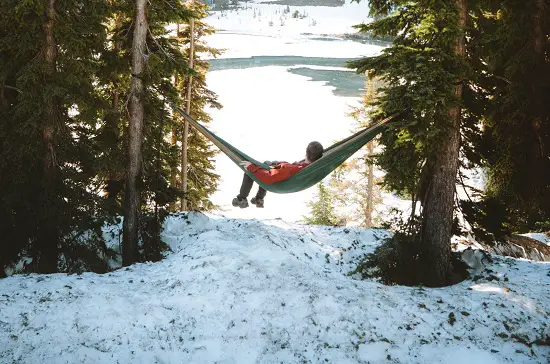Camping in the winter, especially in hammocks, can be uncomfortable and challenging for many people. It’s possible to enjoy hammock camping in the early winter when the cold isn’t too extreme yet.
Camping in the open during long nights with a clear sky and a cup of cocoa can be a unique and unforgettable experience. With the proper planning, strategy, and equipment, hammock camping can be as comfortable as you want.
To make the most of your hammock camping experience, it’s crucial to follow some tips and tricks. For instance, avoid camping in areas with high winds, and plan and choose the right camping gear. Bringing along some pillows, a quilt, and an extra rain fly can add comfort. And remember to pack a hot water bottle and a pee bottle for convenience.
This post has some interesting tips for camping in a hammock in the winter that will take your camping to the next level. So, without further ado, let’s dive right in!

Avoid windy areas.
- As the cold wind can make you uncomfortable and even cause sickness, you must avoid setting up your hammock in open and windy areas. Instead, choose natural windbreak areas such as rock formations, hills, and clusters of trees to shelter you and your gear.
Take Advantage of the Sun
- In the winter, sunlight is scarce, and it is vital to take advantage of it when setting up camp. Look for an open area with plenty of sunlight and position your hammock accordingly. The sunlight will help you stay warm and dry your clothes and equipment if they get wet.
Make Camping Plans
- You need to decide if you want to go hammock camping in the winter before you can begin planning the camp. How cold the winters typically get in your region is a significant factor.
- Hammock camping is a great option if you live in a region that doesn’t get much snow and rarely drops below -17 °C (0 °F). Don’t go hammock camping if there’s a chance of snow, sleet, or freezing rain.
Prepare for Some Hammock Camping
- If you’ve never been hammock camping before, practicing a couple of times before committing to the real thing is wise. You can pitch a tent in your yard and keep tabs on everything you’ll need for the most abundant level of relaxation. The key to avoiding problems is to be well prepared.
Select the Simplified Approach.
- If you’re interested in trying hammock camping in the winter but are nervous about the unpredictable weather, camping in your garden is a far more secure option.
- Your home is a haven where you can micromanage your belongings without venturing into the bitter cold. Plus, it’s a great place to spend a weekend evening with the whole gang, including Fido.
Choose the Correct Equipment
- Choose hammock camping gear with the appropriate temperature rating. Items’ temperature ratings should be at least 20 degrees Fahrenheit (7 degrees Celsius) lower than the lowest temperature you anticipate experiencing. Although the gears are certified for the coldest temperature they can withstand, rather than your comfort level, this rating is crucial.
Getting the Right Hammock
- There aren’t any hard and fast guidelines to follow when shopping for a high-quality hammock suitable for use during the colder months of the year when camping. Choose a high-quality hammock that will last you a long time.
- Parachute nylon, the material most commonly used to make hammocks, is known for its durability but offers no thermal protection. Although some more modern designs include insulation pockets, comfort should be your top priority.
Hammocks We Believe You Will Enjoy
We’ve included three of the top hammocks currently available. You could put money into them, or you could look elsewhere. You get to decide.
- Wise Owl Outfitters: Although it can be compressed into a small size, it is surprisingly strong and durable. This hammock has a lot of room for two people.
- Bear Butt: This hammock is professionally crafted, with sturdy straps and a solid frame that will serve you well for many years. It’s colorful and stylish, and it’s also very comfy.
- OneTigris Anti-Bacterial Hammock: The ideal temperature range for this hammock is between 5 and 20 degrees Celsius. It is an excellent option to keep you warm even in the coldest winters.
Warm the sleeping bag up
- When the day’s sightseeing and other activities are over, it’s time to crawl into your sleeping bag, right? Nonetheless, before you head indoors, it’s a good idea to warm your sleeping bag so you can crawl into it feeling toasty and comfortable. That way, when you finally get into your sleeping bag, you won’t be jolted awake by the sudden chill.
- Fill a metal water bottle with the boiling water on the stove when dinner is over. Then, slip the metal water bottle under the duvet. Once the house has warmed up, you can retire for a restful night’s sleep. It’s also an excellent place to store your water bottle.
Prepare a Fire for the Hours Following Sunset
- You should be aware of the value of fire. It provides you with a source of heat to help you get through the long, cold winter nights; protection from potentially dangerous animals; the ability to cook your food; and a light source to help you navigate the dark.
- Before lighting a fire, construct a fire pit to contain the flames in one area and prevent them from spreading. It’s also recommended that you bring some excellent firewood with you. Firewood from the campsite should be considered.
To stay warm, dress in layers.
- To survive a winter camping trip without frostbite, you must master layering your clothing. The act of layering is simple. Resources on the internet will walk you through the steps if you need help with how to do it.
- Layering your clothing lets you keep your body temperature comfortable, even in subzero conditions. Try layering your clothing to avoid feeling too hot or cold, regardless of the weather.
It’s Critical to Have a Quilt Under Your Bed
- Your winter hammock camping arsenal would be complete with an underblanket to accompany your hammock and sleeping pad. They stay in place under the hammock, protecting you from the elements and keeping you warm.
- If you want to prevent the wind from penetrating the nylon of your hammock, an underquilt is your best bet. You can sleep soundly, knowing you’re protected from the chill of winter winds. It’s essential to have underquilts whose combined surface area is at least as massive as your hammock’s overall surface area.
Cover it with a tarp.
- There are many advantages to putting a tarp over your hammock. First, a tarp protects against excessive wind, rain, and snow. Second, a tarp helps trap the warmth of the hammock’s surroundings.
- A tarp should be set up low and close to the hammock. Wrap the tarp around the tree to protect the area above your campsite. The tarp should be laced with sturdy ropes close to the hammock. You can expect optimal performance from it.
Final Thoughts
Camping in a hammock during the winter can be challenging if you need more preparation. Therefore, this camping style presents several health and safety risks and is not recommended for novice campers.
Max, a passionate lumberjack and outdoors enthusiast, loves fishing, camping, and hunting. He has extensive experience in the great outdoors and is eager to join Outdoor Fun Mag to share his adventures and knowledge. Whether you’re a seasoned pro or just starting out, Max promises to bring laughter, learning, and an unforgettable outdoor experience.

